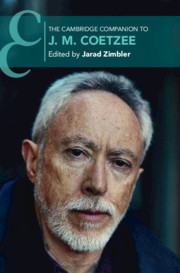Book contents
- The Cambridge Companion to J. M. Coetzee
- The Cambridge Companion to J. M. Coetzee
- Copyright page
- Contents
- Contributors
- Acknowledgements
- Chronology
- Abbreviations
- Introduction
- Part I Forms
- Part II Relations
- 6 Translations
- 7 Collaboration and Correspondence
- 8 Criticism and Scholarship
- 9 Influence and Intertextuality
- 10 Worlds, World-Making, and Southern Horizons
- Part III Mediations
- Further Reading
- Index
- Series page
9 - Influence and Intertextuality
from Part II - Relations
Published online by Cambridge University Press: 26 April 2020
- The Cambridge Companion to J. M. Coetzee
- The Cambridge Companion to J. M. Coetzee
- Copyright page
- Contents
- Contributors
- Acknowledgements
- Chronology
- Abbreviations
- Introduction
- Part I Forms
- Part II Relations
- 6 Translations
- 7 Collaboration and Correspondence
- 8 Criticism and Scholarship
- 9 Influence and Intertextuality
- 10 Worlds, World-Making, and Southern Horizons
- Part III Mediations
- Further Reading
- Index
- Series page
Summary
This chapter begins by describing some of the main lines of influence on Coetzee, including major literary figures, philosophical and theological traditions, and a range of South African writers and thinkers. It distinguishes the psychoanalytic and philosophical registers in which the concept of intertextuality has been discussed by such figures as Roland Barthes and Julia Kristeva, as well as (more implicitly) by writers including Fyodor Dostoevsky and Samuel Beckett. Most broadly, it develops an argument that Coetzee was not simply influenced by this way of thinking about the nature and value of literature. Instead, his fiction can be understood as a complex engagement with both the imaginative power and the moral problems that it generates.
Keywords
- Type
- Chapter
- Information
- The Cambridge Companion to J. M. Coetzee , pp. 152 - 167Publisher: Cambridge University PressPrint publication year: 2020
- 1
- Cited by

